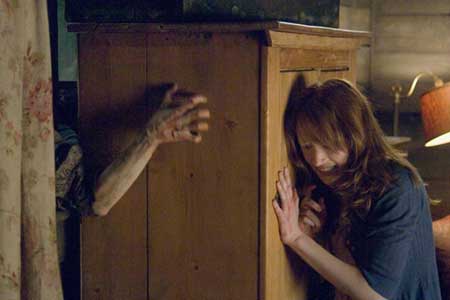CABIN IN THE WOODS Movie Review: Is It Worth The Hype?
- Details
- Category: New Series and Movie Reviews
- Published: Friday, 13 April 2012 06:49
- Written by Alissa Norby

It’s a familiar set-up that instantly sends both the horror connoisseur and averse newcomer into fits of eye-rolls: a virgin, a jock, a brain, a beauty and a stoner traipse into an isolated cottage for a weekend of free-fall debauchery before facing their imminent doom. But Joss Whedon and Drew Goddard’s “The Cabin in the Woods”, a rare genre offering that relies on the horror audience’s oft-ignored ability to both scrutinize and squirm, isn’t interested in delivering familiars.
Having previously broken genre rules while partners on “Buffy the Vampire Slayer”, Whedon and Goddard still ensure that every definitive element of the modern-day horror narrative swings in full force here, from the introduction of lascivious college coeds to the foreboding encounter with the woods-dwelling locals. Yet it’s a wholly original insertion, a romp that relishes its genre’s insipid clichés while giddily skewering them.
Before Thor, Chris Hemsworth Was At A CABIN IN THE WOODS (Video)
This coyly self-referential vantage is established immediately as Goddard introduces his viewers to Sitterson (Richard Jenkins) and Hadley (Bradley Whitford), two bureaucratic types prepping for what we’re told is a major event in their underground laboratories. Cut to the quintet of undergrad archetypes, where the seemingly naïve Dana (Kristen Connolly) is preparing for a trip with her carefree best friend Jules (Anna Hutchison), Jules’ quarterback boyfriend Curt (Chris Hemsworth), a potential match and scholar (Jess Williams), and the town stoner (Fran Kranz), with collapsible Thermos bong in tow.Yet like its initially disorienting exposition, nothing- and no one- is quite as it seems. Dana (as the proverbial virgin) has been having a sexual affair with her professor, athletic Curt is on full academic scholarship, and Jules as the bimbo is also pre-med.
It is from this point onward that neither Goddard nor Whedon is content to allow their viewers the freedom to rest on the established laurels, or predictability, of the typical cinematic slasher. With its ornate and winding maze of hapless victims, sinister puppeteers, and redneck zombies, “The Cabin in the Woods” raises its eyebrow without pointing a finger at our obsession with gruesome death as a form of popcorn entertainment. Every inch of culturally-specific horror fodder is on trial here, from the Japanese focus on ghastly schoolgirls to Americans’ fascination with rural outliers. “You get used to it,” one of the lab technicians assured a newcomer after witnessing a particularly barbaric offing. “Should you?” asks another.
For all of its meta criticism, “The Cabin in the Woods” does not waiver on the blood-soaked butchery. Alternating between a scream and a wink, there is no shortage of human entrails in Goddard and Whedon’s crucible-like landscape (think more “Evil Dead II” than “The Texas Chainsaw Massacre”). It is gleefully saturated with multiple decapitations, literal gut-wrenching, and a scythe through the neck.
But the film’s main weapon of choice is its questioning, albeit lack of outright criticism, of our allegiance to the rules put in place by most horror movies. Why must the virgin live when all others parish? Why does death solely rely on the characters’ inability to tap into basic common sense (“Let’s all split up. We’ll cover more ground that way”)? “The Cabin in the Woods” may not be a complete game-changer as the marketing may tout, but it does present a compelling case that it is time to shake-up the game.